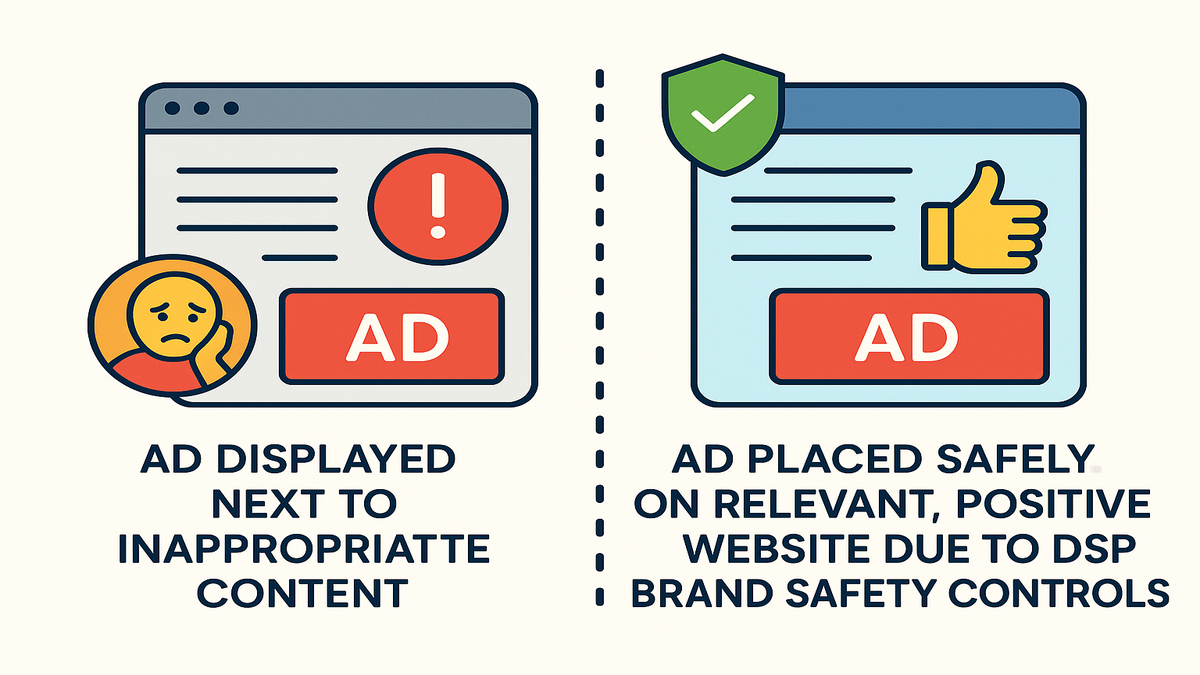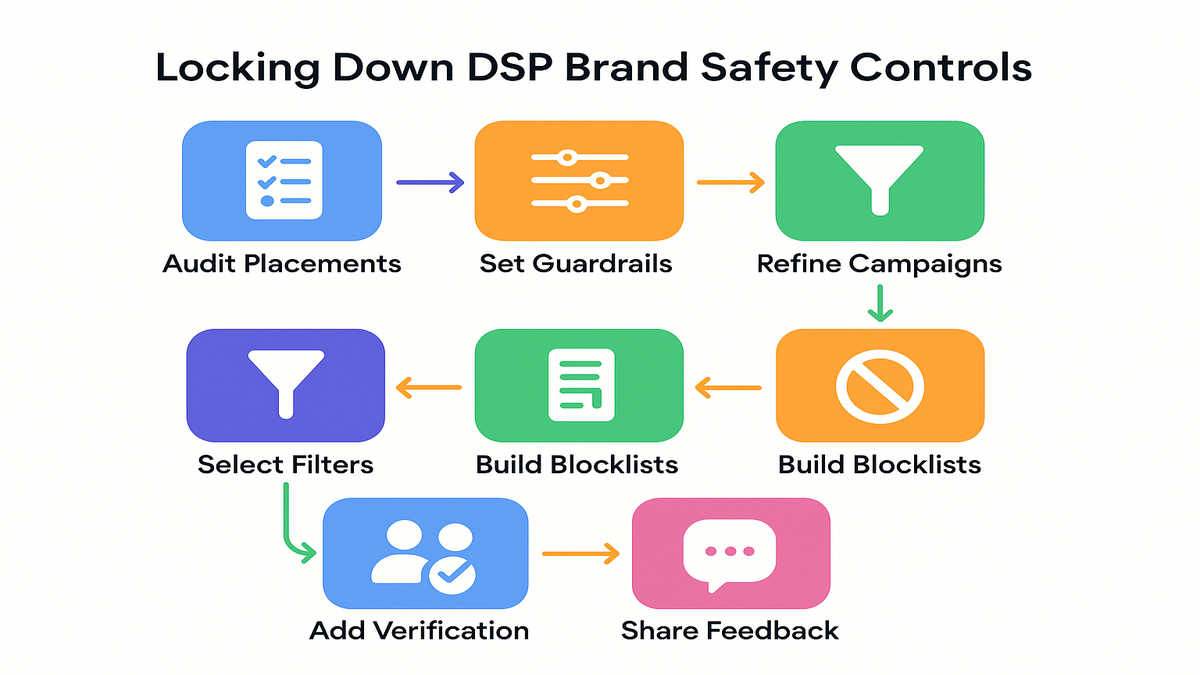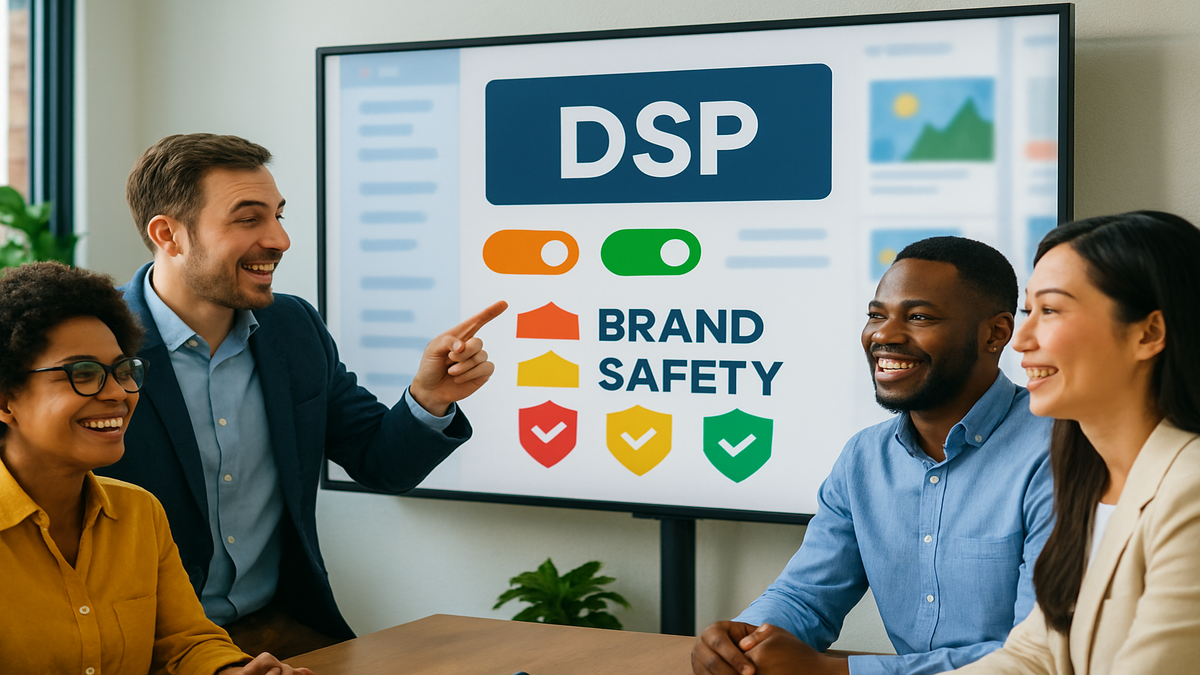
How DSP Brand Safety Controls Protect Your Ad Dollars

If you spend big on online ads, you know the nightmare. You wake up and boom—your campaign is sitting next to a trash-fire meme or, yep, something even worse. Your boss sees it, trust tanks, and your CFO comes by like, “Who thought that was a good idea?”
Thing is, you don’t have to live like this. No more praying to the ad gods. Enter Demand-Side Platforms (DSPs). You can finally control where your ads show up in real time now. Your brand is safe. Your team actually sleeps at night. And maybe—just maybe—your CFO stops glaring your way.
Stuck on how DSP controls work? Not sure about targeting or brand protection? Check out our DSP Services for Amazon advertisers. We explain the tough stuff and set you up with solid tools.
Plot twist: Amazon, Adobe, and Facebook dropped open beta brand safety controls. These aren’t just bells and whistles. They’re super detailed, automated, and pretty much the closest you get to putting your cash exactly where you want it.
“Nine out of ten digital advertisers rate brand safety as their top concern—because all it takes is a single misplacement to go viral, for all the wrong reasons.” — eMarketer
TL;DR
- DSPs now have next-level controls for where your ads appear.
- Automatic filtering comes from big names like DoubleVerify, IAS, Comscore, Peer39.
- Pick brand safety rules for the full account, or at ad-group level.
- Some controls cost more—watch out, they're not all free.
- Amazon's shiny controls are out first on Twitch for Display & Video ads.
- See exactly where your ad spend goes—real reports, not mystery ones.

Why Brand Suitability Isn’t Just a Bonus
The Danger
It’s not just about clicks and views. Place one ad by a shady conspiracy blog or, yikes, NSFW stuff, and suddenly you’re a meme in someone’s group chat. Not scaremongering—the Trustworthy Accountability Group says 80% of people judge brands badly if their ad's next to gross or offensive stuff. Worse, their urge to buy drops by half. That’s way more than a little bruise.
It’s about trust, not embarrassment. You might work years to build it—one screenshot tears it all down. This isn’t just trolls; numbers show that bad ad spots can wreck your rep, get you boycotted, and freak out investors.
Industry Shift
DSPs used to dump your ad everywhere, kinda like that friend who crashes every party—good or bad. “Spray and pray” worked in the early days. Now? Nope. As advertisers got louder, DSPs like Facebook, Adobe, and Amazon had to change fast. Enter: brand suitability dashboards. These let you avoid crazy inventory—fake news, clickbait, hate, or just weird off-brand stuff.
"Brand suitability went from a checkmark to a boardroom talk," says Kelly McKnight at Integral Ad Science. “It’s not just can you run ads—it’s should you?”
Filters by tone, topic, mood—makes less drama, fewer all-hands meltdowns. These also let you grow ad plans without fear.
How DSP Brand Safety Settings Work
The Controls
With the new beta features, picture two big dials:
- Advertiser-Level: These are your hard rules. Never near violence, hate, adult, or politics. They’re your brand’s seatbelt.
- Ad-Group Controls: You can get fancy here. Maybe your tech ad can sit near gaming content, but your family one shouldn’t. Tune these per campaign while the basic rules stay locked.
For example, Amazon’s beta for Twitch lets you do this by API, with rules like brandSafetyTierInheritedSettingDetails for account-wide stuff, and brandSafetyTierTarget for ad-group changes. Not a coder? No problem—your DSP partner helps in their easy dashboards.
Third-Party Superpowers
This is where the tech wizards jump in—DoubleVerify, IAS, Comscore:
- Kill fake traffic (goodbye, bots!). No more wasting spend on junk.
- Block whole nasty categories (crime, clickbait, adult, whatever).
- Exclude specific keywords, so your ad never gets near the stuff you fear.
- Ban bad publishers. Got a brand enemy? Hit “block” just once.
Example: Adobe DSP and DoubleVerify scan placements before you spend. If your rule is "no violence ever," it’s locked down. No money lost, more peace of mind.
Suitability vs. Safety
Brand Safety
Brand safety is your wall. No exceptions. No hate, no crime, no wild conspiracies—nobody wants their ad there. Ever.
Brand Suitability
Brand suitability is about being picky—by your rules. Red Bull likes wild stuff, but The North Face might hate it. Suitability lets you:
- Pick your vibe (block sad news if you want positive only)
- Sort by category (no hunting, but okay with outdoor? You choose)
- Filter by emotion (keep it neutral, no doom-and-gloom)
Eric Wheeler at 33Across says it best: “Suitability grows your reach and trust—you decide what fits.”
Suitability in Real Life
- Edgy sneakers? Try TikTok, music, live events; avoid bank news.
- Life insurance? Stick to positive, family-friendly channels—skip crime and fear talk.
- Eco brands? Go for science and green living spaces, not sad disaster stories.
These controls keep your brand’s voice clear and, hopefully, not weird.

Automation and Open Beta
Not a Black Box Anymore
Old controls were like locked boxes—you threw in money, hoped for the best. Now, top DSPs show you everything:
- Real-Time Reports: See the exact site, app, or creator where your ad showed up.
- Inventory Rules: Auto block-lists, set filters, adjust fast. So much easier.
- Tech + Human: Machines block junk, but you can step in and tweak things as needed.
Open Beta Benefits
The best part? Open beta means you help make the rules. Turn on a feature, spot a bug, give feedback. Platforms update stuff fast. These tools become what you need—not just what the tech folks think you want.
Clear Reports
No more fuzzy reports. Now you get:
- What you bought, and where.
- See which websites, apps, or publishers worked, and which failed.
- Clear tips on where to add or ease up on blocks.
Beta Features at Work
Placement & Context Controls
This is how pros do it:
- DoubleVerify Filters: Set by placement. Topics or sites you don’t like? Blocked before you even bid.
- Context Filters: Want to avoid adult or political themes? Or stick only to sports? Easy.
- Dynamic Blocklists: If you spot a sketchy app or site, block it instantly.
- API Exclusions: Use keywords or vibe filters at tech speed. No waiting.
Lauren Fisher at Advertiser Perceptions sums it up: “Advertisers want a way to block bad stuff and green-light the good. Open beta lets you do both.”
Checks, Reporting & Moving Money
With DSP dashboards and partners like Peer39, you can:
- Catch bad placements before they blow up.
- Move budgets quick—ditch anything that looks risky, double-down where it works.
- Layer in real-time bot and scam stops.
Result? Budgets go further. No more wasting cash on the junk. You actually learn what works for your own brand.
The Fine Print
Who Gets Access
- Amazon DSP: For now, these top safety controls work only on Twitch (Display & Video). Fine-tune rules at account or ad-group level. Your feedback helps Amazon pick what’s next.
- Adobe DSP: Deep DoubleVerify integration, detailed context control, flexible blocklists.
- Facebook: Growing its own brand control center. More dynamic, covers feed, video, lots more.
Stuff is rolling out fast. Not every feature is everywhere. Check your own setup before making promises.
How Much You’ll Pay
Heads up: extras cost extra. Third-party checks like DoubleVerify, advanced keyword blocks—those can add fees. Charges might come per impression, segment, or as a paid feature. Best bet: check your bills and set budgets to cover these tools.
Beta Channel Coverage
Remember, open beta means not every ad channel works yet. Twitch audio, for example, isn’t there yet. Why? DSPs want you to test, break things, and suggest fixes. The tools get better each round.
"Advertiser feedback during beta is huge—it shapes what DSPs launch," says Maya Holmes at Amazon Ads. Don’t be shy. Speak up and drive improvements.
Big Picture
Let’s sum it up:
- Suitability controls are now sharp, automated, and as flexible as your coffee order.
- DoubleVerify, Peer39, IAS, Comscore catch the stuff DSPs miss—bots, fakes, and toxic spots.
- Whole account or just ad-group controls? You set the lanes for every ad.
- Top-tier controls cost more—plan and budget for them.
- Use good reports to adjust and keep your brand protected.
FAQs
What’s the difference between brand safety and suitability?
Brand safety blocks anything illegal or wild (hate, violence, drugs). Suitability is about what your brand wants, even if others are okay with it.How do DSPs automate suitability?
By teaming up with tools like DoubleVerify. You set the rules. Automation shields you until you say otherwise. Want to loosen rules for something special? Just do it.Are these only for video ads?
With Amazon DSP, controls work on Display and Video for Twitch. Adobe and Facebook are adding more: native, mobile, in-stream. More is coming soon.Do third-party checks raise the price?
Mostly yes. Premium filters, special keyword rules—they cost extra. You’ll see these on your invoices. Adjust budgets to match.Can I see exactly where my ads go?
Yes. New reports tell you which sites, apps, and channels delivered. Spot risky places, add to the blocklist, and keep growing safe spots.How do I give feedback on beta features?
API and dashboards have feedback forms. Use them. Tell your DSP what’s not working or missing—more feedback means faster fixes.
DSP Suitability Moves
- Check Current Placements: Look over where your ads have run. Remove anything sketchy.
- Set Account Guardrails: Drop in universal “never-run” filters (hate, crime, adult stuff).
- Tune by Ad Group: Special ad? Adjust rules just for it.
- Use Topic & Keyword Filters: Block bad themes, allow the good ones. Change as you go.
- Keep Blocklists Fresh: Regularly update what’s off-limits as new sites pop up.
- Check Reports, Pivot Fast: Reviews mid-campaign. See a problem? Shift budget right away.
- Bring in Verification Partners: Use DoubleVerify, Peer39, IAS, Comscore for the best results.
- Give Feedback: Don’t just accept defaults. Tell your DSP what helps—or what’s broken. This makes the tools work better for everyone.
Look, digital trust is money now. If you’re not controlling your ad placements, someone else is—and it could cost you. One bad placement can go viral for all the wrong reasons. Custom, automated suitability controls aren’t a bonus—they’re your brand insurance plan.
Ready to boost your DSP skills? Dive into Amazon Attribution, try a live Brand Lift study, or grab our DSP optimization guide for your next campaign.
Want easier brand safety, clearer reports, and better placement tools? See our exclusive Features built just for online advertisers like you.
References
- Amazon Advertising: Brand Safety and Suitability Roadmap
- DoubleVerify Authentic Brand Safety
- Integral Ad Science: Brand Safety
- Comscore: Brand Safety Solutions
- Adobe DSP Brand Safety
- Amazon DSP API Brand Suitability Settings
- eMarketer: The Importance of Brand Safety
- Trustworthy Accountability Group: 2022 Consumer Trust Survey
- 33Across: Brand Suitability News
- Advertiser Perceptions Reports

